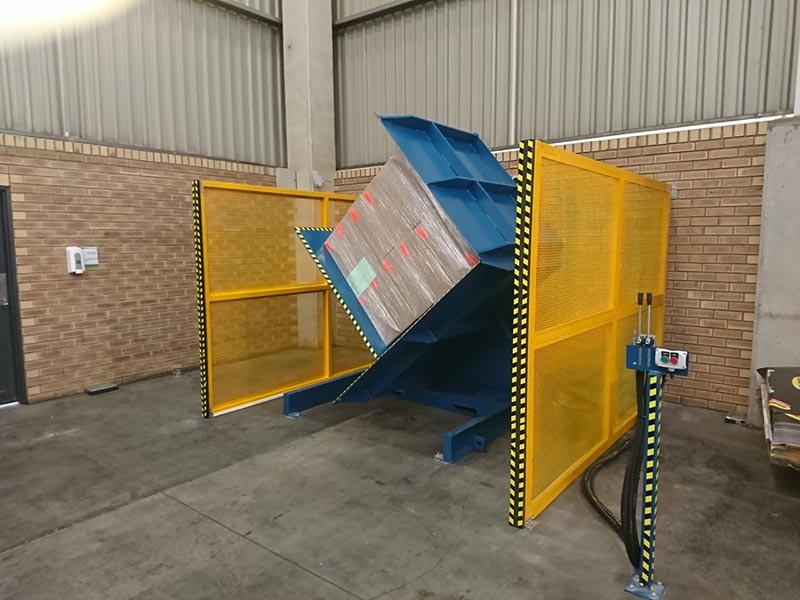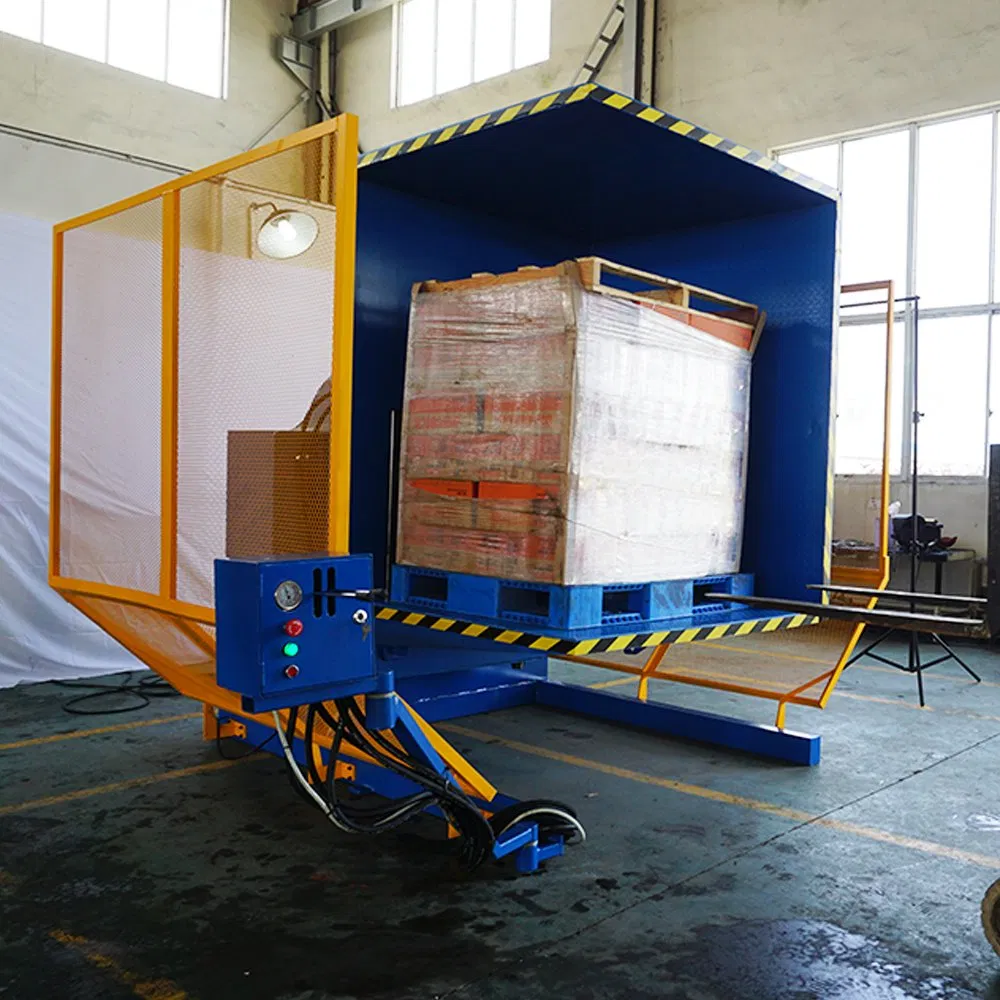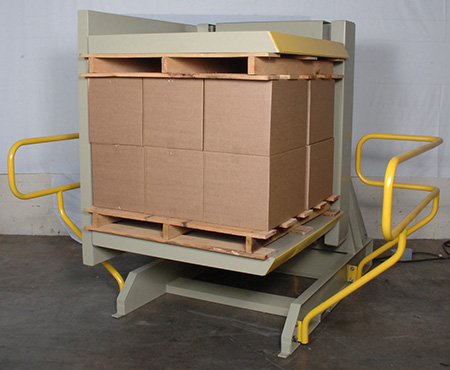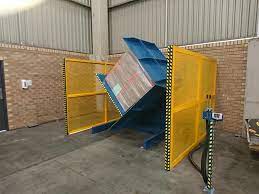Cutting Downtime in Thailand: How Pallet Changing Machines Help
Are you constantly battling production delays in your Thai factory? It feels like every time you solve one bottleneck, another one appears. You've optimized production lines and trained your staff, but unexpected downtime from manual handling, damaged goods, or broken pallets keeps eating into your profits and causing shipping delays. You know there must be a better way to manage your logistics, a way to make your operations smoother and more reliable, but the solution seems just out of reach.
A pallet changing machine, also known as a pallet inverter or pallet transfer system, is an automated or semi-automated piece of equipment designed to solve these exact problems. It efficiently transfers a full load of goods from one pallet to another. This process is crucial for companies in Thailand that need to switch from in-house wooden pallets to plastic export pallets, rescue goods from a broken pallet, or simply improve overall warehouse hygiene and efficiency, directly cutting down on operational downtime.

I've spent my entire career on the factory floor, first as an engineer and now as a factory owner myself. I’ve seen firsthand how small inefficiencies can snowball into major operational headaches. The problem of downtime is universal, whether you're in steel production or food processing. In this article, I want to share my experience and break down exactly how this specific piece of equipment can be a game-changer for your operations in Thailand. We will look at how it works, the direct impact on downtime, the financial benefits, and the improvements in safety. Let's dive in.
What Exactly is a Pallet Changing Machine and How Does it Work?
Does the process of manually transferring goods from one pallet to another feel slow, risky, and outdated? You watch your team spend valuable time unstacking and restacking boxes, increasing the risk of product damage and worker injury with every move. This manual process creates a significant bottleneck in your logistics chain, especially when you need to switch to export-compliant pallets or deal with a damaged one. You need a solution that is fast, safe, and reliable.
A pallet changing machine is a mechanical system that automates the transfer of a full load of goods from one pallet to another without manual handling. The most common type, a pallet inverter, clamps the entire load, rotates it 180 degrees, allows the old pallet to be removed from the top, and then a new pallet is placed before rotating the load back to its original orientation. This entire process can be completed in under a minute.

When I first started my journey in this industry, I saw this problem everywhere. A client in the food and beverage sector in Thailand was struggling with this exact issue. They needed to switch from their internal wooden pallets, which were not always clean, to sanitized plastic pallets for shipment to Europe. Their manual process was taking over 20 minutes per pallet load and resulted in frequent product spills and contamination risks. Introducing a simple pallet inverter changed everything. It not only cut the transfer time to about 60 seconds but also eliminated the manual handling, which drastically reduced product damage and improved their overall hygiene standards.
How Different Types of Pallet Changers Function
Not all pallet changers are the same. The right choice depends on your specific needs, such as the type of product, the volume of pallets you handle, and your available space. Understanding the core differences is the first step toward making a smart investment. Let's break down the most common types.
| Machine Type | Operation Method | Best For | Key Advantage |
|---|---|---|---|
| Pallet Inverter (180° Rotation) | Clamps the load, rotates it 180°, allows for pallet exchange at the top, and rotates back. | Boxed goods, stable sacks, durable items. | Speed and simplicity. The most common and versatile type. |
| Pallet Changer (Push-Pull System) | Pushes the entire product load from the old pallet onto a new pallet waiting alongside it. | Block-shaped, stable loads that can withstand pressure. | No rotation needed, which can be gentler for some products. |
| Load Tilter (90° Tilt) | Tilts the load 90°, allowing the pallet to be slid away and replaced. | Rolls of paper, coils, or items sensitive to full inversion. | Avoids full inversion pressure on the product. |
The Mechanics of a 180° Pallet Inverter
Let's look closer at the most popular model: the 180° pallet inverter. The process is elegantly simple yet powerful.
- Loading: A forklift places the entire palletized load onto the machine's platform.
- Clamping: Two powerful clamping walls, often hydraulically powered, move in to securely hold the load from both sides. The pressure is adjustable to protect delicate goods while ensuring stability for heavy ones.
- Inversion: The entire platform, with the clamped load, rotates a full 180 degrees. The original pallet is now on top, upside down.
- Exchange: The operator can now easily lift the old pallet off with a forklift or pallet jack. A new pallet (e.g., a plastic export pallet) is then placed on top of the inverted load.
- Return: The machine rotates back 180 degrees to its starting position.
- Release: The clamping walls retract, and the forklift can now remove the load, which is perfectly stacked on its new pallet.
This mechanical process replaces a labor-intensive, time-consuming, and error-prone manual task with a swift, controlled, and safe automated one. For a factory owner, this translates directly into higher throughput and reduced operational risk.
How Can Pallet Changers Directly Reduce Operational Downtime?
Are you tired of seeing your production schedule derailed by logistical hiccups in the warehouse? A single broken pallet can bring a whole shipment to a halt, forcing your team to scramble. This unplanned downtime isn't just a minor delay; it cascades through your operations, affecting shipping deadlines, customer satisfaction, and your bottom line. You need to find a way to make your material handling more resilient and predictable.
Pallet changers directly reduce operational downtime by transforming a slow, unpredictable manual task into a fast, standardized, and automated process. By quickly replacing broken or non-compliant pallets, they prevent bottlenecks at critical points like shipping docks or production line outfeeds. Instead of hours of manual restacking, a pallet transfer is completed in minutes, keeping your entire logistics chain moving without interruption.

I remember a client in Thailand's automotive parts industry who faced constant delays. Their parts were stacked in large bins on wooden pallets. Occasionally, a forklift would damage a pallet just as it was about to be loaded onto a truck. The entire truck would have to wait while workers manually transferred hundreds of heavy parts from the broken pallet to a new one. This could take over an hour, often causing them to miss their scheduled shipping window. After they installed a pallet changer, the same incident became a minor inconvenience. A broken pallet was identified, whisked to the changer, and the entire load was on a new pallet in less than two minutes. The truck left on time, and a major source of downtime was eliminated.
Pinpointing the Sources of Downtime
To appreciate the solution, we first need to dissect the problem. In a typical Thai factory, pallet-related downtime comes from several sources. By addressing each one, a pallet changer provides a comprehensive solution.
Scenario 1: Damaged Pallet Recovery
This is the most common and disruptive scenario.
- Without a Pallet Changer: A forklift driver notices a broken pallet runner. The load is now unstable and unsafe to move, lift, or ship. Operations stop. A team of two or three workers is called over. They must manually unstack the entire load, box by box, onto a new pallet. This is slow, physically demanding, and introduces a high risk of dropping and damaging the product. The process can take anywhere from 30 minutes to over an hour, depending on the load.
- With a Pallet Changer: The forklift driver takes the damaged pallet directly to the changer. The machine secures the load, inverts it, and the broken pallet is removed. A new one is put in its place. The entire cycle takes about 90 seconds. The load is secure, the product was never touched by hand, and the forklift is back to work. The downtime is reduced by over 95%.
Scenario 2: Switching to Export Pallets
Many countries, especially in Europe and North America, have strict regulations (like ISPM 15) for wooden pallets or require plastic pallets.
- Without a Pallet Changer: Your goods are ready for shipment on your standard in-house wooden pallets. Now, they must be transferred to expensive, treated export pallets. Again, this requires a full manual unstacking and restacking process for every single pallet being shipped. It's a massive, planned bottleneck that consumes hours of labor and warehouse space.
- With a Pallet Changer: The process becomes part of the standard workflow. As pallets are staged for shipping, they run through the changer. The switch from a standard pallet to a certified export pallet is done in seconds. There is no extra labor, no staging area clogged with workers, and no risk of damage during the transfer. This allows you to use cheaper, standard pallets for internal operations and switch to premium pallets only when absolutely necessary, saving costs and time.
Scenario 3: Quality Control and Hygiene
In industries like food, beverage, and pharmaceuticals, you cannot allow a dirty or low-quality wooden pallet from a supplier to enter your clean production environment.
- Without a Pallet Changer: Incoming goods must be unloaded and restacked onto your own sanitized, in-house pallets at the receiving dock. This slows down your receiving process significantly and creates a point of potential contamination.
- With a Pallet Changer: You can create a clean-room barrier. All incoming goods on external pallets are processed through a pallet changer at the receiving dock. The goods are transferred to your internal pallets before they ever enter the main facility. This maintains the integrity of your production environment and streamlines the receiving process.
What are the ROI and Cost-Saving Benefits of Pallet Changers for Thai Factories?
As a factory owner, you're constantly analyzing every investment. You ask yourself, "Will this new equipment really pay for itself?" You're under pressure to reduce operating costs and improve profit margins, so any capital expenditure must have a clear and compelling return on investment (ROI). You can't afford to invest in something that doesn't deliver tangible financial results.
A pallet changer delivers a strong ROI by drastically cutting labor costs, reducing product damage, and increasing operational throughput. The savings from eliminating manual handling and preventing downtime often lead to a payback period of 12 to 24 months. For a Thai factory, this means you are not just buying a machine; you are investing in a more profitable and efficient operational model that directly impacts your bottom line.

I walked through this exact calculation with a client who runs a cold storage facility near Bangkok. They were hesitant about the initial cost. So, we sat down and did the math together. They were using three workers to manually transfer frozen goods from wooden to plastic pallets to prevent wood contamination in their freezers. It took them about 25 minutes per pallet. We calculated their labor costs, the occasional product loss from thawing during the long transfer, and the time their forklifts were idle. Then we compared it to the one-time cost of a pallet inverter and its minimal electricity use. The numbers were clear. The machine would pay for itself in just under 18 months, and after that, it would generate pure savings every single day. Seeing it broken down like that made the decision easy for him.
Breaking Down the Return on Investment (ROI)
To truly understand the financial impact, let's look at a hypothetical but realistic scenario for a mid-sized factory in Thailand. We'll compare the annual costs of manual pallet changing versus using a machine.
Assumptions:
- Pallets per day: 20 pallets require changing (due to damage, export, etc.).
- Manual Method: 2 workers, 20 minutes per pallet.
- Machine Method: 1 operator, 2 minutes per pallet (including travel time).
- Average Labor Cost (Thailand): THB 400/day per worker, approx. THB 50/hour.
- Product Damage Rate (Manual): 1% of goods are damaged during transfer.
- Average Value per Pallet Load: THB 30,000.
Cost Analysis: Manual vs. Machine
Here is a side-by-side comparison of the annual operational costs.
| Cost Factor | Manual Pallet Changing | With a Pallet Changer | Annual Savings |
|---|---|---|---|
| Labor Time | 20 pallets * 20 min = 400 min/day (6.67 hrs) | 20 pallets * 2 min = 40 min/day (0.67 hrs) | 6 hours/day |
| Annual Labor Cost | 6.67 hrs 2 workers THB 50/hr * 250 days | 0.67 hrs 1 operator THB 50/hr * 250 days | THB 158,375 |
| Cost of Product Damage | 20 pallets THB 30,000 1% * 250 days | Negligible (assumed 0% for calculation) | THB 150,000 |
| Total Annual Operating Cost | THB 166,750 (Labor) + THB 150,000 (Damage) = THB 316,750 | THB 8,375 (Labor) | THB 308,375 |
Note: This calculation does not even include secondary costs like forklift idle time, production delays, or missed shipping deadlines, which would further increase the savings.
Assuming the purchase and installation cost of a suitable pallet changing machine is around THB 450,000, the payback period can be calculated as:
Payback Period = Initial Investment / Annual Savings = THB 450,000 / THB 308,375 ≈ 1.46 years (or about 17.5 months).
After the first 17.5 months, the machine continues to save the company over THB 300,000 every year. This is the kind of practical, verifiable ROI that makes sense to any business owner focused on long-term stability and profitability. It turns a recurring operational expense into a capital investment that pays dividends for years to come.
How Do Pallet Changers Improve Safety and Meet Thailand's Labor Standards?
Are you concerned about workplace accidents and the physical strain on your employees? Manual handling of heavy, repetitive loads is a leading cause of back injuries and other musculoskeletal disorders. These injuries not only affect your workers' well-being but also lead to lost workdays, increased insurance premiums, and potential compliance issues with Thailand's labor laws. You have a responsibility to provide a safe working environment.
Pallet changers significantly improve workplace safety by eliminating the need for manual stacking and unstacking of goods. This automation removes the primary cause of injuries associated with pallet handling, such as back strain from lifting and foot injuries from falling objects. By creating a more ergonomic and controlled process, these machines help factories in Thailand meet and exceed occupational health and safety standards, protecting their most valuable asset: their people.

As an engineer, efficiency has always been my focus. But as a factory owner, the safety of my team became my number one priority. I’ll never forget visiting a potential client’s warehouse. I saw two young workers struggling to restack 20kg sacks of plastic resin from a broken pallet. They were tired, their movements were getting clumsy, and it was an accident waiting to happen. The supervisor told me back injuries were their most common incident report. That image has stuck with me. It’s a powerful reminder that the best solutions don't just improve numbers on a spreadsheet; they improve people's lives. Automating that task isn't about replacing workers; it's about moving them from dangerous, low-value work to safer, higher-value roles like operating machinery or quality control.
Mitigating Risks: A Direct Comparison
Let's break down the specific safety risks involved in manual pallet changing and see how a machine mitigates each one. This is crucial for aligning with Thailand's Occupational Safety, Health and Environment Act B.E. 2554 (2011), which requires employers to manage and minimize workplace risks.
Risk 1: Musculoskeletal Injuries (MSIs)
- Manual Method: This is the highest risk area. Workers repeatedly bend, lift, carry, and twist while moving boxes or bags. A standard pallet can hold up to 1,000 kg of product. Even if items are lifted one by one, the cumulative strain over a day is enormous. This directly leads to chronic back pain, shoulder injuries, and hernias.
- Machine Solution: The pallet changer does all the lifting. The worker’s role changes to that of an operator, using controls to manage the process. The physical strain is completely eliminated. This is a proactive engineering control, which is the most effective way to prevent MSIs.
Risk 2: Slips, Trips, and Falls
- Manual Method: The area around a manual pallet change can become cluttered with products, wrapping, and debris from a broken pallet. This creates trip hazards. Spilled liquids or powders from damaged goods can also create slip hazards.
- Machine Solution: The process is contained within the machine's footprint. The load remains consolidated, and there is no debris scattered across the floor. The work area stays clean and organized, drastically reducing the risk of slips and trips.
Risk 3: "Struck By" and "Crushed By" Accidents
- Manual Method: Improperly stacked goods can become unstable and fall on workers during the transfer process. A worker could have their foot caught under a shifting load or be hit by a falling box from the top of the stack.
- Machine Solution: The load is securely clamped by the machine's walls before any movement occurs. The entire operation is controlled and predictable. Safety features like light curtains or safety cages are standard on modern machines, which automatically stop the operation if a person enters the work zone. This prevents any possibility of a worker being struck or crushed by the load.
By investing in a pallet changer, a factory owner in Thailand is not just buying a piece of equipment. They are implementing a comprehensive safety system that protects their workers, ensures legal compliance, and fosters a positive safety culture within the organization.
My Personal Take: A Lesson from the Factory Floor
When I look at a machine like a pallet changer, I don't just see steel and hydraulics. I see a solution to the kinds of problems that kept me awake at night when I was first managing a production line. I know what it’s like to have a major shipment for a key client ready to go, only to be told there's a delay because a forklift driver broke a single wooden pallet. I know the frustration of watching my best workers perform a slow, back-breaking task that adds no real value. And I know the pressure from the top to cut costs and increase efficiency, just like Javier Morales faces in his steel mill.
The challenges in a Thai electronics factory might seem different from those in a Mexican steel mill, but the core principles of manufacturing are the same. We all fight against downtime. We all face pressure on costs. And we all need our equipment to be reliable. An aging production line, whether it's making wire coils or assembling circuit boards, becomes a source of unpredictability. That’s the real enemy: unpredictability. It ruins schedules, inflates costs, and damages customer trust.
Investing in a pallet changer is a strategic move against unpredictability. It's a small step, but it's a powerful one. It takes a chaotic, manual, and unpredictable point in your logistics chain and makes it smooth, automated, and clockwork-reliable. This isn't just about saving a few minutes on a pallet transfer. It's about building a more resilient, more efficient operation from the ground up. It’s a step towards the kind of factory you want to run—one where you can confidently promise 95% uptime because you've systematically eliminated the sources of failure. It's a foundational piece in the puzzle of digital transformation and operational excellence that leaders like Javier are trying to solve.
Conclusion
Ultimately, pallet changing machines solve critical bottlenecks. They cut downtime, reduce costs, and improve safety, turning an unpredictable problem into a reliable and efficient part of your daily operations.



